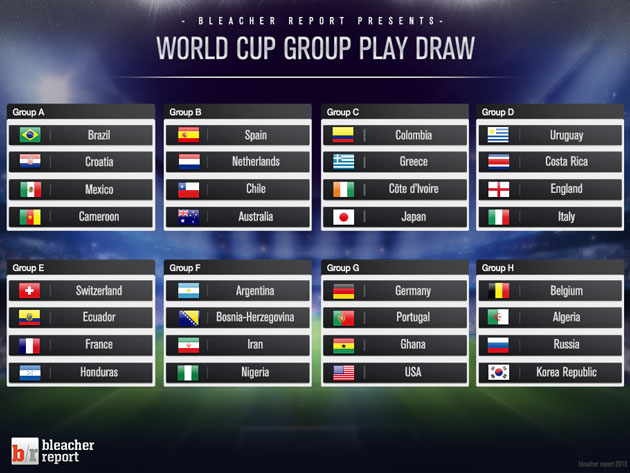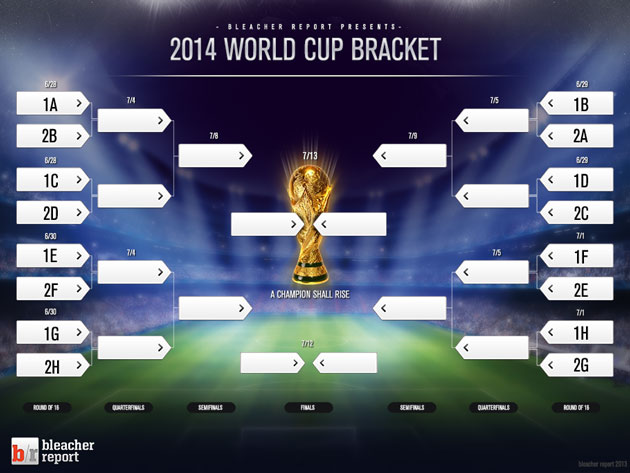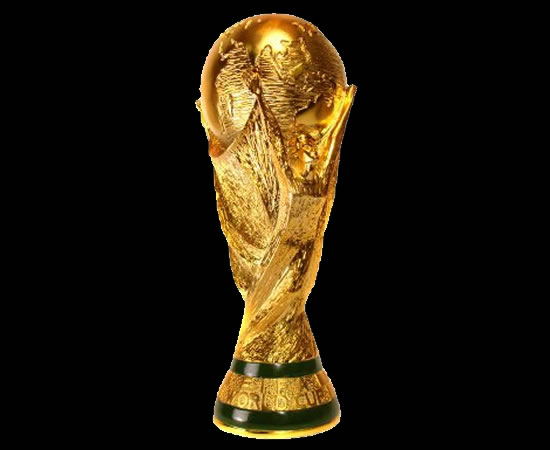
The World Cup is an international soccer tournament that takes place every four years. Every four years, 32 different nations compete to take home the World Cup trophy. The first World Cup took place in Uruguay in 1930.
This coming summer, the 2014 World Cup will be held in Brazil. On December 6, 2013 the final draw occurred which put the 32 teams into their respective groups. Below is an image of the 8 groups drawn together for this year's World Cup.

The world is broken into 6 FIFA continental zones for World Cup qualification. The six zones are Africa (CAF), Asia (AFC), North and Central America and Caribbean (CONCACAF), South America (CONMEBOL), Oceania (OFC), and Europe (UEFA).
Each zone is allocated a certain amount of berths based on the strength of the confederations' teams. For the 2014 World Cup, UEFA possesses 13 automatic berths, the most of all zones, followed by CAF with 5, AFC with 4, CONMEBOL with 4 plus the host, Brazil, and CONCACAF with 3.
As you may notice, this only adds up to 30 berths while there are 32 teams that participate in the tournament. Those 30 berths are known as automatic berths. The 2 remaining spots are determined by playoffs. The best team from the OFC, the 5th place team from the AFC, the 6th place team from the CAF, and the 4th place team from the CONCACAF are all thrown into a pot. Then, two teams are paired together via the draw of the pot. For example, for the 2014 World Cup the OFC winner played the 4th place team from the CONCACAF, and the 5th placed team from the AFC played the 6th placed team from the CAF.
From there, each team plays the team they were paired against twice. One at their home field, and the next at the other's home. The 2 winners are decided based off of the aggregate. An aggregate is the combined score of the two matches played. If the aggregate is tied, then the tiebreaker goes to the team that scored the most away goals. If that is the same, then it is decided by penalty kicks. The 2 teams that win their playoff are then given a berth into the World Cup to fill the remaining 2 spots.
Once all 32 teams have qualified there is a World Cup draw held usually in the first week of December. A couple of days before the actual draw, the FIFA committee decides the format the draw will follow for that year's draw and the ball that will be used for the upcoming World Cup. The World Cup draw format changes each time in order to protect one rule of the draw. No more than two European teams can be in the same group together. For the 2014 World Cup draw, the committee made a confusing move. They placed the 7 top seeded teams plus the host, Brazil, into Pot 1, the 2 non-seeded teams from CONMEBOL and the 5 non-seeded teams from CAF into Pot 2, the 4 non-seeded teams from CONCACAF and the 4 non-seeded teams from AFC into Pot 3, and the remaining 9 non-seeded teams from UEFA into Pot 4. Below is a table of what the four pots looked like.
| Pot 1 | Pot 2 | Pot 3 | Pot 4 |
|---|---|---|---|
| Brazil | Algeria | Australia | Bosnia and Herzegovina |
| Argentina | Cameroon | Japan | Croatia | Colombia | Ivory Coast | Iran | England |
| Uruguay | Ghana | South Korea | France |
| Belgium | Nigeria | Costa Rica | Greece |
| Germany | Chile | Honduras | Italy |
| Spain | Ecuador | Mexico | Netherlands |
| Switzerland | United States | Portugal | |
| Russia |
As you can see, Pot 4 has 9 teams and Pot 2 only has 7 teams so the draw wouldn't work out evenly. To even the numbers out, one team from Pot 4 was randomly drawn and placed into Pot 2. Now, the problem was Pots 1, 2, and 4 each possessed a European team which made it possible that 3 European teams could be drawn together. To prevent this, they made a fifth pot, called Pot X. Before any teams were placed in Pot X, Pot 1 was distributed among the groups A-H with Brazil being predetermined as the spot A1. Then, all of the South American seeded teams were placed in this Pot X. One team was drawn out of Pot X and was automatically paired with the European team in Pot 2 to avoid the rule of georgraphic seperation. The draw then proceeded as normal distributing out teams one by one from each pot into groups A-H.
Now that we are done talking about all of the events leading up to the tournament, let's talk about the tournament itself.
By now you probably know that the tournament consists of 8 groups of 4 teams. In the World Cup, there are 5 different stages, the Group Stage, Round of 16, Quarterfinals, Semifinals, and Finals. In the group stage, each group plays a round robin within their own group. For each win a team gets 3 points, a tie 1 point, and a loss 0 points. The top 2 from each group move on the Round of 16. In the case of a tie in points after all 3 matches have been played, the tiebreaking procedures are as follows:
If two or more teams are still tied after the above 3 criteria, their rankings will be determined by the following:
Once the top 2 teams are decided from each group, bracket play begins. The bracket format looks like the image below.

In the Round of 16, A1 plays B2, C1 plays D2, E1 plays F2, G1 plays H2, A2 plays B1, C2 plays D1, E2 plays F1, and G2 plays H1. Based off of the results from the bracket games will decide who will play each other in the Quarterfinals, then the Semifinals, and lastly the Finals.
Once the final whistle blows of the World Cup Final one champion is crowned and gets to take home the World Cup trophy with them back to their home country. Below is an image of the beautiful World Cup trophy.

Here is list of the teams that have won the World Cup. It includes how many times they have won the World Cup and what years they won it in.
Obviously, the top three teams with the most titles are Brazil with 5 including back to back championships in 1958 and 1962, Italy with 4 also having back to back championships in 1934 and 1938, and Germany with 3.
For more information visit:
2014 Fifa World Cup